On this page
Frank M. ChapmanThis page lists books written by, or including a substantial contribution by, Frank M. Chapman.The books are ordered by publication date with the most recent at the top.
|
|
|
|
Life In An Air Castle: Nature Studies In The Tropics
Frank M. Chapman
Illustrations: Francis L. Jaques
D. Appleton & Company
1938
|
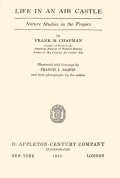 |
|
Autobiography of a Bird LoverFrank M. Chapman
Four colour plates: Louis Agassiz Fuertes
D. Appleton & Company
1933
|
Buy from amazon.co.uk
Buy from amazon.com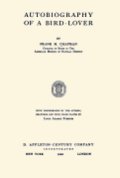
|
|
Fifty Years' Progress of American Ornithology : 1883-1933Editor: Frank M. Chapman and T.S. Palmer
American Ornithologists' Union
1933
Contents:
- Introduction - F.M. Chapman and T.S. Palmer
- A Brief History Of The American Ornithologists' Union - T.S. Palmer
- American Ornithological Literature: 1883-1933 - Witmer Stone
- Fifty Years Of Bird Migration - William Rowan
- Bird Banding - F.C. Lincoln
- The Theory Of Territorialism And Its Development - Margaret M. Nice
- Advances In Life History Work - Herbert Friedmann
- Economic Ornithology - W.L. McAtee
- Collections Of Birds In The Unied States And Canada: Study Collections - J.L. Peters
- Collections Of Birds In The United States And Canada: Exhibition Collections - F.M. Chapman
- History And Progress Of Bird Photography In America - A.O. Gross
- Fifty Years Of Progress In American Bird-Art - G.M. Sutton
- Fifty Years Of Bird Protection - T.G. Pearson
- Ornithological Education In America - A.A. Allen
- Fossil Birds - Alexander Wetmore
|
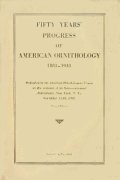 |
|
The Upper Zonal Bird-Life Of Mts. Roraima And Duida
Bulletin Of The American Museum Of Natural HistoryVolume LXIII
Frank M. Chapman
1931
Introduction: In 1927, the American Museum despatched the Lee Garnett Day Expedition to Mt. Roraima at the junction of British Guiana, Brazil, and Venezuela. The following year, in continuation of the same biological project, the Tyler Duida Expedition was sent to Mt. Duida, Venezuela, about 400 miles south-southwest of Mt. Roraima. In a preliminary paper' on the birds of the Day Expedition it was said that a fuller report was deferred in the hope that collections then being made by the Tyler Expedition on Mt. Duida would throw some light on the problems presented by the bird-life of Mt. Roraima. This hope, it is believed, has been fulfilled. The fauna hitherto supposed to be largely restricted to the upper life-zone of Mt. Roraima has been found in the corresponding life-zone of Mt. Duida, thereby widely extending the area it occupies and confirming many phenomena in distribution which previously had rested solely on our knowledge of the Roraiman fauna. Furthermore, the boundaries between life-zones are so much better defined on Duida than they are on Roraima that the problems of the origin of its zonal forms are correspondingly simplified. In view, therefore, of the similarity of the bird-life of these two mountains and of the questions arising from its study, it is obvious that a report on our Roraiman and Duidan collections should be contained in a single paper. This report was completed June 1, 1931.
|

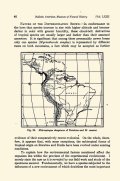
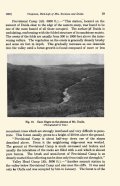 |
|
My Tropical Air Castle: Nature Studies In Panama
Frank M. Chapman
D. Appleton & Company
1929
|
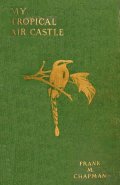
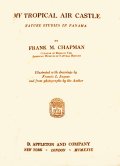 |
|
Distribution of Bird Life in Ecuador: A contribution to a Study of the Origin of Andean Bird Life
Bulletin Of The American Museum Of Natural HistoryVolume LV
Frank M. Chapman
4 colour plates: Louis Agassiz Fuertes
Numerous other illustrations, figures and photographs
1926
Example text: Although Ecuador, in proportion to its size, has the richest avifauna of any South American republic, it was almost the last to receive the attention of ornithologists. Chile had her Molina (1782) and Gay (1847); Patagonia her Darwin and Gould (1841); Paraguay her Azara (1802-5); Brazil her Wied (1830-33) and Spix (1824-25); Guiana, von Schomburgk, and Cabanis (1848); Bolivia, d'Orbigny (1835-47); and Peru, von Tschudi (1844). As early as 1838 or 1839 dealers began to ship native-made bird skins from Bogota to Paris, and in 1842 Prince Adelbert of Prussia found in Rio Janeiro a dealer named Besecke who employed thirty hunters and had at that time about 35,000 bird-skins in stock.' But there is no definite record of a bird's skin from Ecuador until 1844 when Lesson described four species from Guayaquil, all of which are characteristic of the region and doubtless, therefore, came from the locality named.
|

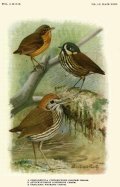
 |
|
The Distribution Of Bird Life In The Urubamba Valley Of PeruA Report On The Birds Collected By The Yale University National Geographic Society's Expeditions
Frank M. Chapman
Bulletin 117
Smithsonian Institution / United States National Museum
1921
From the introduction: The work of the Yale University-National Geographic Society's Expeditions in the Urubamba region of Peru, under the direction of Prof. Hiram Bingham, has included not only the archaeological investigations which have made the country explored so widely known, but also researches in other branches of science, the whole being designed to form a comprehensive survey of the physical conditions and biological resources of the area under consideration. The task of making collections in vertebrate zoology was entrusted to the well-known naturalist, Edmund Heller, formerly of the Biological Survey, and the representative of the United States National Museum on the Roosevelt Expedition to British East Africa. The fact should be emphasized that Mr. Heller's first object in the field was the collection of mammals, and every one familiar with the difficulties of mammal collecting in the Andes will appreciate the skill and energy he displayed in amassing a collection of no less than 884 specimens. In collecting birds Mr. Heller attempted to secure species rather than specimens and his collection, therefore, contains a much larger number of forms than its size would lead one to expect.
|
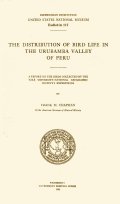
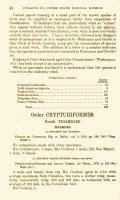 |
|
What Bird Is That?
Frank M. Chapman
Illustrations: Edmund J. Sawyer
1920
There were a number of later editions of this book. The cover image shown may be that of a later edition.
|
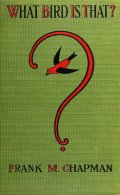
 |
|
Our Winter Birds: How To Know And How To Attract Them
Frank M. Chapman
Illustrations: Edmund J. Sawyer
1918
From the introduction: When we go to the fields and woods in winter, birds are the only living creatures we are sure of seeing. Tree Sparrows chatter happily over their breakfast of seeds; a Nuthatch stops his search for insects' eggs long enough to look down and greet us with his queer yank-yank. A Downy Woodpecker, intent on the capture of a grub, hammers industriously, tap-tap-tap. He is too busy to stop, but calls his clear peek to us as we pause to watch him. What a sense of companionship we have with these feathered friends of ours! They make us feel at home with Nature. How lonely we should be without them! We are indebted to these winter birds for more than their friendship; for more than giving life to the otherwise silent fields and woods. They are our active allies in the warfare to save our crops and forests from the army of insects that ceaselessly at- tack them. The Tree Sparrows breakfasting on seeds, the Nuthatch hunting insects eggs, the Woodpeckers digging out grubs, were all working for us. The Chickadees that accept our invitation to luncheon repay us a countless number of times for the suet and nuts we offer them.
|


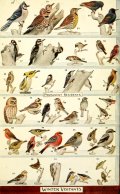 |
|
The Distribution Of Bird-Life In Colombia; A Contribution To A Biological Survey Of South AmericaFrank M. Chapman
Photographs / illustrations: Arthur A. Allan, Frank M. Chapman, Leo E. Miller, Louis Agassiz Fuertes
Bulletin Of The American Museum Of Natural History, Volume XXXVI
1917
|

|
|
The Travels Of Birds: Our Birds And Their Journeys To Strange LandsFrank M. Chapman
D. Appleton And Company
1915
Example text: When we consider the great distances some birds travel and the dangers they encounter by the way, it is remarkable that they usually arrive on time. That the daily trips to and from the roost should be made regularly is not surprising. The birds have only a short way to go, and they leave soon after daybreak and return just before dark. But when, year after year, the Bobolink, the Baltimore Oriole, the midget Humming-bird, many Warblers and other birds arrive from journeys thousands of miles in length on exactly or nearly the same day, we ask how they can possibly be so prompt. In order to answer this question we must know something about the birds' time-table. Anyone who has studied the birds about his home for many years can make a time-table giving the dates of the arrival and departure of all the migratory birds which visit him. In this time-table we will notice that the early birds those which come in March are much less prompt than the later ones those which come in May. This is because the weather of March is so much more uncertain than that of May. In some years, near New York City, snow covers the ground and the ponds are frozen almost until April. In others, the snow melts and the ice disappears before the middle of March. But by May i, the weather is more settled. The first week in May of one year is much like the first week in May of another year.
|
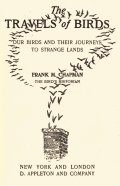
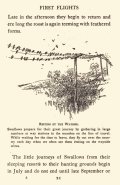
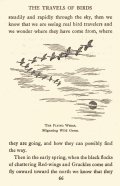 |
|
Handbook Of Birds Of Eastern North AmericaFrank M. Chapman
Color and b/w plates: Louis Agassiz Fuertes
Drawings in text: Tappan Adney and Ernest Thompson Seton
D. Appleton And Company
Revised edition
1912
From the introduction: In preparing a revised edition of the Handbook, it was decided that any increase in size which would remove it from the ranks of true handbooks was not to be considered for a moment. The question, then, with which I have been confronted, was, how, within given hmits, to meet the wants of the bird student of today, who demands, primarily, information concerning the bird in nature. To add materially to the space given to each of the species contained in the first edition would result in widely overstepping the bounds set by necessity. But, if it were not possible to present a complete biography of every bird, at least a suggestive biography of the bird could be given, and the expansion in size permitted has been largely used for this purpose. This added material will be found in the introductory pages, which number 116, as compared with 31 in the original edition.
|
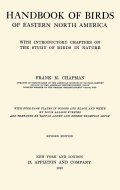

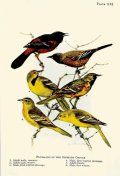 |
|
The Habitat Groups Of North American Birds In The American Museum Of Natural HistoryFrank M. Chapman
Guide Leaflet Series No. 28
American Museum Of Natural History
1909
Opening lines: The groups of birds contained in this hall are designed to illustrate not only the habits but also the haunts or "habitats" of the species shown. Each group usually includes the nest, eggs and young, besides the adult bird or birds, with a reproduction of from 60 to 160 square feet of the nest's immediate surroundings. To this accurate and realistic representation of the hoine of the species is added a painting from nature of its habitat, the real foreground being connected with the painted background in such a manner that one often does not at first see where the former ends and the latter begins. The whole, therefore, gives an adequate conception of the nature of the country the birds inhabit and the conditions under which they live. It should be clearly understood that these backgrounds are not more or less fanciful sketches of the haunts of the birds associated with them, but they are careful studies from nature of definite localities, and therefore possess a geographical as well as an ornithological value.
|
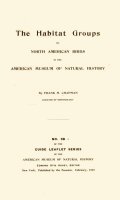
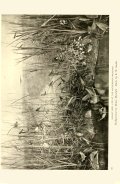 |
|
Camps And Cruises Of An OrnithologistFrank M. Chapman
With 250 Photographs From Nature By The Author
D. Appleton & Company
1908
Example text: The nature of the work for which, in the main, the field studies herein recorded have been made, has led me to the more remote parts of our country; but I should convey a wholly wrong impression of the possibilities of bird study, if I permitted this volume to appear without saying a word of the opportunities which lie within the reach of the local bird student. Continuous and definitely directed observation is the secret of success in the study of bird-life; and only that permanency of residence which permits us to keep a close watch on the species, through the year, and on the individual through the nesting season, will enable us to write an adequate history of its life. I would emphasize the necessity of specialization. It may almost be said with truth that most of our knowledge of birds has been acquired by accident, so haphazard have been our methods of study. But, for this very reason, there is abundant opportunity for the student who, not content with a general knowledge of birds, determines to make himself an authority on some particular bird, preferably the one most abundant in his own neighborhood. If he does justice to his subject, he will never lack an outlet for his ornithological ambitions.
|
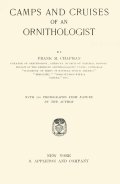
 |
|
The Warblers Of North AmericanFrank M. Chapman
Illustrations: Louis Agassiz Fuertes and Bruce Horsfall
D. Appleton & Company
1907
Includes 24 colour plates. From the preface: The warblers have been described as "our most beautiful, most abundant, and least known birds." The knowledge that at certain seasons our woods, and even the trees of our larger city parks are thronged with an innumerable host of birds, the brilliancy of whose plumage rivals that of many tropical species, comes to the bird student with the force of a surprising discovery. One never forgets one's first Warbler! Highly migratory, the extended journeys of Warblers are nevertheless performed with regularity which makes their appearance in the spring a fixed calendar event. The very essence of the season is in their flitting forms and lisping voices; without them May would seem a dreary month and the migration of birds lose half its charm. But these dainty, fascinating sprites of the tree-tops are elusive. Years of observation may be required to add to one's list of field acquaintances the last of the thirty-odd species which, in eastern North America, may be found at a single locality. In this quest the field-glass student is handicapped. The small size of Warblers, their activity, the nature of their haunts, their rapid journeys, marked seasonal changes in plumage, and the general resemblance in the song of many species all tend to render recognition in life unusually difficult. This book has, therefore, been prepared with the cooperation of other ornithologists, to meet the demand for a fully illustrated work which will serve as an aid to the field identification of Warblers and to the study of their life-histories.
|

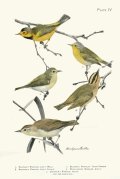
 |
|
Color Key To North American BirdsFrank M. Chapman
With upwards of 800 drawings by Chester A. Reed
Doubleday, Page & Company
1903
Preface: To learn to call a bird by its right name is the first step in the study of ornithology. We may propose to investigate the structure, food, and habits of the birds of the world, or desire merely a superficial knowledge of the species found in our garden, but in either case we are at once confronted by this question of identification. From the scientific point of view there is but one satisfactory way to identify a bird. A specimen of it should be in hand in order that its form, color, and size may be accurately determined, when, with the aid of analytical keys, with which most text-books are provided, it is a simple matter to ascertain the bird's name. Wide experience has shown the writer, however, that where one dead bird is identified, hundreds of attempts are made to name the living bird in nature. This is to be expected. It is the natural outcome of the recent remarkable interest in the study of birds which, fostered by Audubon Societies and nature study teachers, has assumed an ethical and educational importance of the first magnitude. We cannot place a gun in the hands of these thousands of bird- lovers whom we are yearly developing; indeed most of them would refuse to use it. Specimens, therefore, are rarely available to them and we should make some special effort to meet their peculiar wants. The present volume has been prepared with this end in view. Identification of the bird in the bush is its sole end; an end, however, which we trust will prove but the beginning of a new and potent interest in nature.
|
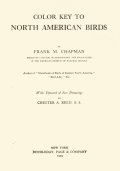
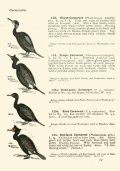
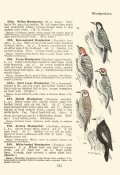 |
|
The Economic Value Of Birds To The StateFrank M. Chapman
Color plates: Louis Agassiz Fuertes
State Of New York Forest, Fish And Game Commission
1903
From the preface: The bird is the property of the State. From this fundamental conception of the bird's legal status there can be no logical ground for dissent. If a certain species of bird is conclusively proven to be injurious to the agricultural or other interests of the State, no one would deny the State's right to destroy that species. If, on the contrary, a species is shown to be beneficial, then the State has an equal right to protect it. Indeed, we may go further and say it is not only the right, but the duty of the State to give to its birds the treatment they deserve. Here is the great Commonwealth of New York with agricultural and forestry industries which annually yield products valued at $266,000,000. In the closest relation to the welfare of these industries stands a group of animals represented by some 350 species and millions of individuals. Obviously, then, it is the first duty of the State to learn definitely in what way or ways the presence of these incalculably abundant creatures affects its crops and forests. If they are harmful how are they to be destroyed? If they are valuable how are they to be preserved? In short, the State should take all necessary steps to appraise its vast possessions in bird-life.
|
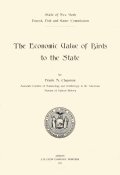
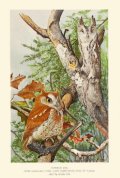
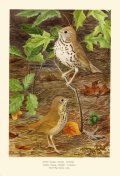 |
|
Bird Studies With A Camera: With Introductory Chapters On The Outfit And Methods Of The Bird PhotographerFrank M. Chapman
With over one hundred photographs from nature by the author
D. Appleton And Company
1900
From the preface: The practice of photographing birds in Nature is of too recent origin in this country to permit of its being treated authoritatively. The methods which may be employed are so numerous, the field to be covered so limitless, that many years must elapse before the bird photographer's outfit will meet his wants, while the constantly varying details which surround his subjects almost prohibit duplication of experience. But it is these very difficulties which render all the more imperative the necessity of conference among workers in this fascinating and important branch of natural history. The causes of both success and failure should, through the medium of books and journals, be made accessible to all, thereby shortening this experimental stage of the study of birds with a camera, and hastening the day when the nature of the outfit and methods shall have been settled with more or less definiteness. It is as a contribution toward this end, and as a means of answering the queries of numerous correspondents, that the following pages, embodying the results of my own experiences, are offered. It is sincerely hoped that they may increase the interest in the study of birds in nature, and at the same time furnish a more profitable and delightful outlet for the hunting instinct than is afforded by the shotgun or rifle.
|

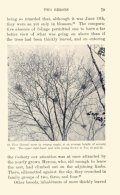
 |
|
Teachers' Manual Of Bird-Life: A Guide To The Study Of Our Common BirdsFrank M. Chapman
D. Appleton And Company
1899
This book was sold with three portfolios of plates:
- Portfolio No. I: Permanent residents and winter visitants, 32 plates
- Portfolio No. II: March and April migrants, 34 plates
- Portfolio No. III: May migrants, eggs, and nests, 34 plates
From the preface:While the time available for zoological studies in our schools is too limited to permit of more than the treatment in outline of most of the classes of animals, the fact is now recognized that birds possess unusual claims to our attention. They are practically the only ones of the higher animals with which we may come in contact daily. Our large mammals have either been exterminated or driven from the vicinity of our homes, while most of the smaller species are nocturnal, and, therefore, rarely seen. Reptiles and batrachians are difficult to observe and are not popular; while fishes, from the nature of their haunts, can be studied only under certain conditions. Birds, however, are everywhere: in field and wood and sky, in our orchards and gardens; and some of them are with us at all seasons.
|
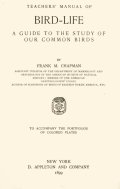
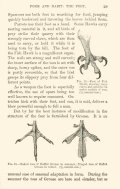 |
|
Bird-Life: A Guide To The Study Of Our Common BirdsFrank M. Chapman
Seventy-Five Full page plates and numerous text drawings by Ernest Seton Thompson
D. Appleton And Company
1897
There were many later editions of this book.
From the preface: How unusual it is to meet any one who can correctly name a dozen of our birds! One may live in the country and still know only two or three of the one hundred and fifty or more kinds of birds that may be found during the year. Nevertheless, these gay, restless creatures, both by voice and action, constantly invite our attention, and they are far too interesting and beautiful to be ignored. No one to whom Nature appeals should be without some knowledge of these, the most attractive of her animate forms. The scientific results to be derived from the study of birds are fully realized by the naturalist. But there are other results equally important. I would have every one know of them: results that add to our pleasure in field and wood, and give fresh interest to walks that before were eventless; that quicken l)oth ear and eye, making us hear and see where before we were deaf and blind. Then, to our surprise, we shall discover that the forests and pastures we have known all our lives are tenanted by countless feathered inhabitants whose companionship will prove a source of endless enjoyment. I would enter a special plea for the study of birds in the schools; for the more general introduction of ornithology in natural-history courses. Frogs and crayfish serve an excellent purpose, but we may not en- counter either of them after leaving the laboratory ; whereas birds not only offer excellent opportunities for study, but are always about us, and even a slight familiarity with them will be of value long after school days are over.
|


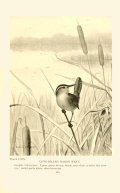 |
|
Handbook Of Birds Of Eastern North AmericaFrank M. Chapman
D. Appleton And Company
1895
From Chapter II: Whether your object be to study birds as a scientist or simply as a lover of Nature, the first step is the same you must learn to know them. This problem of identification has been given up in despair by many would-be ornithologists. We can neither pick, press, net, nor impale birds; and here the botanist and the entomologist have a distinct advantage. Even if we have the desire to resort to a gun its use is not always possible. But with patience and practice the identification of birds is a comparatively easy matter, and in the end you will name them with surprising ease and certainty. There is generally more character in the flight of a bird than there is in the gait of a man. Both are frequently indescribable but perfectly diagnostic, and you learn to recognize bird friends as you do human ones by experience. If you confine your studies to one locality, probably not more than one third of the species described in this volume will come within the field of your observation. To aid you in learning which species should be included in this third, the paragraphs on Range are followed by a statement of the bird's standing at Washington, D. C., Sing Sing, N. Y., and Cambridge, Mass., while the water-birds of Long Island are treated specially. Take the list of birds from the point nearest your home as an index of those you may expect to find. This may be abridged for a given season by considering the times of the year at which a bird is present.
|

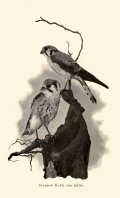
 |
|